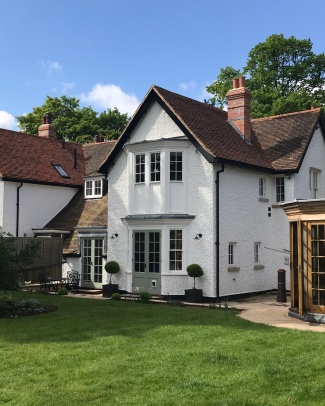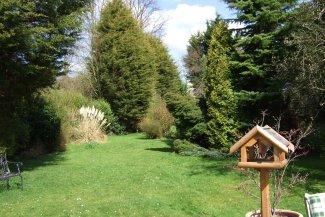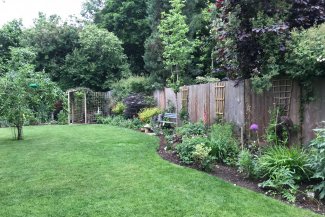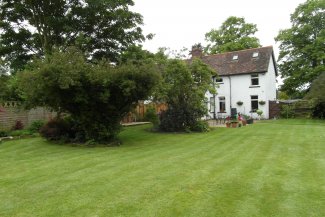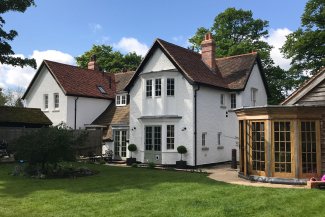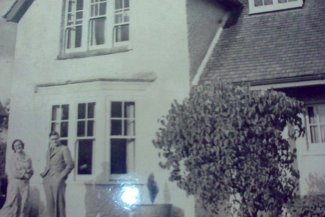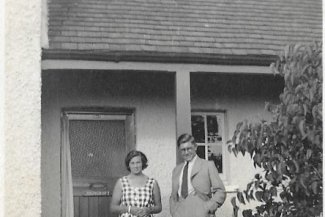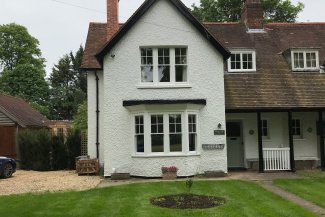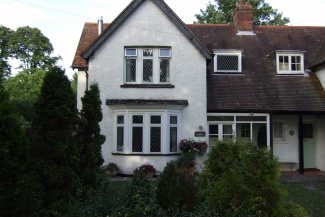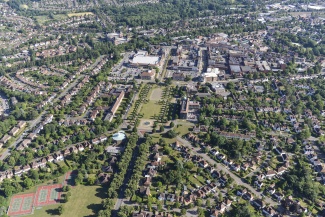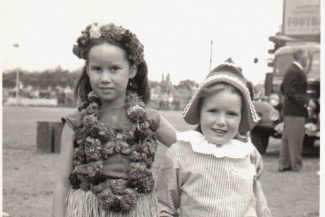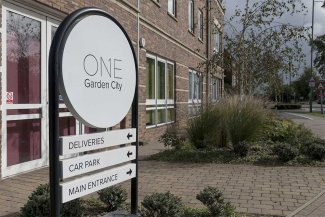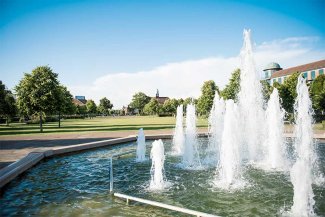In part one of her blog, Janet Capstick wrote about how a chance discovery in the pantry of her new home led to her embarking on a historical path of discovery about her home and Letchworth itself.
In part two, she talks further about bringing her old home back to life and its place in Letchworth’s history.
Garden first
After buying the house, we started work in the garden which was really overgrown and very evergreen. Thirteen mature Leylandi were felled and cleared leaving a quite shockingly barren site and a need for some imagination. We are not designers or professional gardeners so we have had to develop the design gradually over time. I can honestly say that it’s been a blessing that we are so close to the tip as the amount of garden rubbish we have cleared over the years is astonishing – and don’t get me started on the leaves… There is no way we could have composted it all!
Now gradually it is becoming a garden we can share with others (since 2014 we have taken part in the Letchworth Open Gardens) as well as enjoy ourselves and be proud of what we’ve achieved. Although the building works we have been doing over the last two years had taken their toll, we are finally making it all good again, ready for the 2018 Open Gardens later this month (June).
See the photos in the gallery for before and after shots.
A bit of history about the house itself
There are fourteen houses making up the small development known as Eastholm Green but the layout was split in half with the development of the Grange Estate in the 1940s and its access road – Eastern Way. In a reminder to the original layout No.s 1 – 7 are situated on Eastholm and the remainder No.s 8 – 14 on Eastholm Green.
Eastholm Green was the first development by the Garden City Tenants Ltd, a co-partnership tenants housing society established by the Garden City Press Limited in 1905 with the sole objective of “… promoting the erection, cooperative ownership and administration of housing for working men and others on the Garden City Estate …”. The GC Press were a co-partnership printing enterprise and its associated housing society followed in the footsteps of earlier co-partnership societies promoted via the Labour Party Co-Partnership Tenants Housing Council. Henry Vivian MP and Sybella Gurney were Chairman and Hon Sec. respectively and provided much support (both financial and otherwise). On the Management Committee other names of note included Josiah Wedgewood MP and also Bert Williams founder and Manager of the Garden City Press and his colleague H Odell (who later jointly founded Wheeler and Odell Printers in Letchworth) both of whom were early tenants of Eastholm Green. The Society’s auditor was a Mr Trueman and his name appears against the plot of No.13 (my house) on an old site plan. Eastholm Green was initially built for workers at the Garden City Press.
The building of Eastholm Green started in April 1905 and the Cheap Cottages Exhibition opened on 25 July 1905, so not a lot of time to finish cottages for the exhibition! The first pair of cottages erected on the Green were Nos.8 & 9 (funded by Sybella Gurney) and it is likely that these were the only ones finished at the time of the exhibition. This probably explains a missing catalogue entry for the two other pairs marked on the exhibition map - Nos. 13 and 14 and No. 6 and 7.
The Cheap Cottages exhibition featured both non-traditional and more traditionally built cottages. The houses on Eastholm Green are a traditionally brick and roughcast construction, although early postcards show that not all were originally rendered (including mine) but they were by around 1908.
Altogether the Garden City Tenants Limited built over 300 or so cottages between 1905 and the First World War, providing much needed homes for workers in the town. This includes Eastholm Green, Westholm and over 71 cottages the Pixmore Estate (covering Birds Hill, Ridge Road and Pixmore Avenue and Broughton Hill). Parker and Unwin, the garden city architects planned the early estate layouts and designed some of the individual cottages for the Garden City Tenants.
I was absolutely delighted to find such an important connection between my house and one of the pioneering industries of the garden city as well as it being built by an organisation with such a direct and just social cause.
Happy memories
As the cherry on the cake, last year I received an email out of the blue from Martin Rutherford, a gentleman who spent his early years in the house in the 1930 and 40s. Although he now lives abroad, Martin’s brother Tony is still in the UK and last summer they both came to visit me and shared their very happy memories of their childhoods at Letchworth and living at No 13. I also now have photos of the house and garden from the late 1930s too which is really fantastic. Tony and I have kept in touch and he is coming back again this summer with his childhood friend Henry.
The house has played a special part in many lives since it was built and as a result is keeper of many stories. I have only just begun to discover some of them and I feel privileged to add mine to its timeline and proud that we have been able to restore its appearance and charm.
Photos from 1936 and the one from July 2015, both of the front of the house.
Externally we have refitted wooden sash windows, rebuilt chimneys and opened up the front storm porch. We also removed unsightly planting at the front, opening up the frontage onto the Green. All of which we did to make it look exactly like it did when it was originally built.
It isn’t a listed house or one that is architecturally wonderful but to me it is special and deserves due care and attention. No longer is No.13 the ugly kid on the block. The house proudly displays the name Highcroft which I discovered it has always been called. No idea why (yet) but maybe one day I will find out where the name comes from.
Last year we finally finished the rear extension in keeping with the overall look and feel of the house. Even though it is now totally different from the back, it is pleasing to hear people say it looks like it has always been there.
This is such a special place
Personally, I feel there is too much focus on the built environment regarding the heritage of this town. We need to celebrate the much richer story about the town’s pioneers and those that followed. The My Letchworth Blog is a fantastic idea and one way to hear more stories. The more research you do the more interesting this town becomes. There are so many fascinating stories and some really important and influential people were involved, all of whom invested and believed in the vision which became our town.
I have only really scratched the surface in the research I have been involved in to date and I have spent many hours trawling archive material at the Garden City Collection and other sources of archive material held in other locations. Unfortunately, Letchworth’s story has become fragmented and those directly involved are not here to help stitch it back together again. It is easy when a hundred and fifteen years has passed to not fully appreciate the value, impact and achievement of Letchworth. It was described at the time as ‘… a great social experiment of national value’ and borne of a movement for change. But it was also a huge commercial undertaking - to establish a new town for industrial and residential purposes and one which would deliver improved wellbeing for those that lived and worked here.
It certainly wasn’t for the faint hearted, so all credit to the Directors of the First Garden City Company Ltd who did just that, creating a fantastic and lasting legacy here in Letchworth, the world’s first garden city. This heritage goes way beyond just Ebenezer Howard and the architects Parker and Unwin. Letchworth owes its success also to all the shareholders, directors, other investors and most importantly those early manufacturers and residents that believed in the vision and moved their lives here. They created the foundations for this great place and for that reason we should be proud to call Letchworth Garden City our home.
